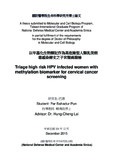Please use this identifier to cite or link to this item:
http://archive.nnl.gov.np:8080/handle/123456789/459| Title: | Triage high risk HPV infected women with methylation biomarker for cervical cancer screening |
| Authors: | Pun, Par Bahadur |
| Keywords: | Cervical cancer HPV Human papillomavirus DNA methylation |
| Issue Date: | 22-Mar-2018 |
| Abstract: | High-risk HPV types of oncogenic human papillomavirus (HPV) types infects cervical epithelium, where HPV 16 and 18 are the most common type. High-risk HPV types are necessary factor that result epigenetic changes leading to progression to cervical cancer. Insufficient specificity of high-risk human papillomavirus (hrHPV) assay in distinguishing relevant high grade precancerous lesions in primary cervical cancer screening results excess unnecessary referral for colposcopy and medical burden. Additional highly specific assays to triage hrHPV-positive women are needed to overcome these drawbacks of HPV assay so as to improve the clinical efficacy of molecular cervical cancer screening. There is potential trend to utilize DNA methylation is a promising biomarker in cervical cancer. However, there are limited clinically useful biomarkers and no DNA methylation biomarkers are at clinical application phase among those biomarkers in spite of promising result. Therefore, we evaluated the clinical performance of potentially methylated candidate genes as a triage assay for hrHPV-positive women which could be translated to clinical application for cervical cancer screening. We conducted a retrospective hospital-based case–control study in Taiwan. Cervical scrapings were collected before colposcopy for hrHPV testing and quantitative methylationspecific PCR (QMSP) of 16 genes. Five genes, POU4F3, HS3ST2, AJAP1, PAX1, and SOX1, were prioritized for the clinical performance to triage hrHPV-positive women while analyzing the clinical performance of these genes in 100 cervical scraping. In the validation phase, two hundred cervical scrapings were randomly classified into a training set (n = 111) and testing set (n = 89). The study group in validation phase comprised 31 and 19 cervical intraepithelial neoplasm I (CIN1), 28 and 27 cervical intraepithelial neoplasia III (CIN3)/ carcinoma in situ (CIS), 18 and 12 squamous cell carcinomas (SCCs)/ adenocarcinomas (ACs) in training and testing set respectively. All samples were tested for hrHPV using a Hybrid Capture II (HCII) assay. HrHPV-positive women were subjected to DNA methylation analysis by real-time quantitative methylation-specific polymerase chain reaction (QMSP) analysis. In the training set, the receiver operating characteristic (ROC) curves defined the optimal methylation index (Mindex) cutoff values for discriminating CIN3+ from CIN1/normal, which then were applied to the testing set. Among the five genes, POU4F3 revealed the highest area under the ROC curve (AUC) (0.86; 95 % CI, 0.78–0.95) in detecting CIN3+. In the testing set, POU4F3 revealed the best clinical performance in triage of hrHPV-positive women with a sensitivity of 74 % and specificity of 89 % for detecting CIN3+. We validated that POU4F3 methylation analysis is a potential molecular tool for triage in detecting CIN3+ in hrHPV-positive women. The combined use of broad-spectrum HPV assay and POU4F3 methylation analysis as a new generation of molecular cervical cancer screening warrants further population-based study. |
| Description: | A thesis submitted to Molecular and Cell Biology Program, Taiwan International Graduate Program of National Defense Medical Center and Academia Sinica in partial fulfillment of the requirements for the degree of Doctor of Philosophy in Molecular and Cell Biology, 2015. |
| URI: | http://103.69.125.248:8080/xmlui/handle/123456789/459 |
| Appears in Collections: | 600 Technology (Applied sciences) |
Files in This Item:
| File | Description | Size | Format | |
|---|---|---|---|---|
| 88.Dr. Par Bahadur Pun _.pdf | 3.58 MB | Adobe PDF |  View/Open |
Items in DSpace are protected by copyright, with all rights reserved, unless otherwise indicated.